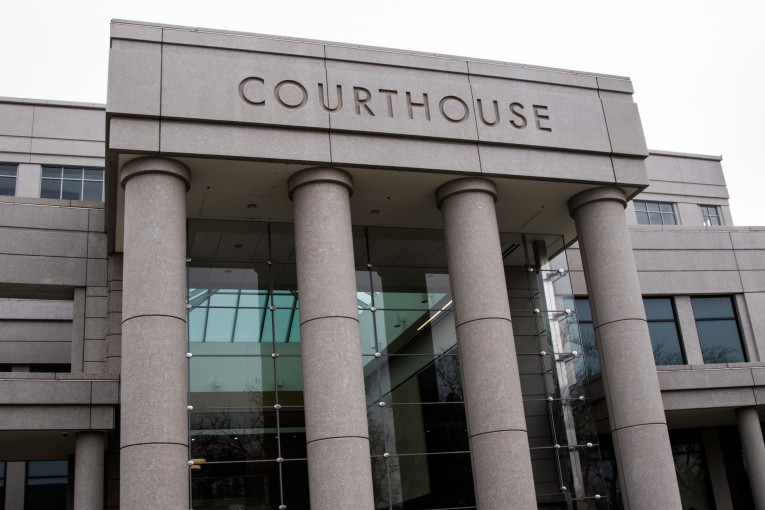

By Cynthia Hoang-Duong, Zainab Antepli, Brinda Kalita and Estefany Romero
WOODLAND, CA – In a jury trial here this week in Yolo County Superior Court, Deputy Public Defender Martha Sequeira pressed a police officer on his failure to investigate before arresting her client, also arguing the prosecution misinterpreted certain aspects of the law when charging the accused.
The accused is facing felony and misdemeanor charges for violating his restraining order and battery with serious bodily injury.
During Thursday morning’s jury trial, Deputy District Attorney Preston S. Schaub questioned Police Officer (first name not available) Torres, who responded to an emergency call detailing a family dispute between the accused and three witnesses in an apartment. Upon entering the residence, the officer testified that he observed a woman holding the accused by his shirt collar—she was later identified as his wife.
Based on these observations, Officer Torres recounted, “I placed [the accused] into handcuffs because he was profusely sweating, breathing heavy, and it appeared there was an altercation.”
He then instructed the accused into his patrol vehicle, before returning to the apartment to interview the witnesses present, including the wife and her brother-in-law, who claimed they were injured.
When asked if anyone requested to go to the hospital, the officer confirmed that the accused sought medical attention for his injuries during the pre-booking procedure and was transported to Woodland Memorial Hospital.
Following the prosecution’s direct examination, the defense highlighted the police officer’s immediate assumption the accused needed to be detained despite his distressed appearance and position against the apartment wall, held by his wife.
“You hadn’t talked to anybody in the apartment before. You just took your observations, assumed he was the villain, and then arrested him and took him outside, correct?” DPD Sequeira pressed.
She then guided Officer Torres through his brief exchange with the accused about requiring medical attention immediately when he entered the patrol vehicle. The accused described to the officer that he was punched in the head and that the male witness pushed and dropped him.
However, despite the accused’s concern for his injuries, the officer admitted that he “didn’t do much” and returned to the apartment after personally viewing his injuries.
Concerned with the accuracy of the officer’s exam of the injuries, DPD Sequeira asked him about the physical indicators that suggest an individual suffered from being struck in the head. In response, Officer Torres confirmed that there are no physical signs of trauma from head injuries.
The defense called Dr. Mathison, an emergency medical specialist who diagnoses internal injuries, to testify if she remembered the accused receiving medical attention. She stated she did not.
She explained medical staff records notes on why patients are receiving medical assistance because there are numerous patients admitted and discharged. She confirmed the patient had bruising marks and showed pictures of the fractures.
After a brief cross-examination and a break, DDA Schaub began his closing statement by instructing the jury that even if they do not feel like they have all the pieces to the story, they have enough to make a verdict.
He also cautioned the jury not to judge witnesses based on how they delivered their testimonies, as there were instances of miscommunication due to language barriers.
The prosecution further clarified the definitions of battery and assault for the jury. Additionally, he reminded the jury of situations that would constitute a violation of a restraining order, such as willingly staying in a place after an individual is informed that the person they must avoid is also in the same place.
Following the prosecution’s closing argument, Judge Tom M. Dyer informed DPD Sequeira to deliver her statements tomorrow, as requested.
But, as Judge Dyer was closing up the courtroom for the day, DPD Sequeira pointed out to the judge and prosecution that the DDA misapplied the 276.3 rule in his closing statement, stating the defense did not agree with his list of situations that can be considered a violation of the restraining order, as presented to the jury during closing arguments.
“This [the disagreement] needs to be said now in the record for appeal purposes,” she added.
However, DDA Schaub argued that the definition of the 276.3 rule that he used in his closing statement was the best way to prop his argument against the accused. According to his interpretation of the law, sections of the rule did not mention specificity about who was harmed, as long as the accused had threatened to harm individuals mentioned in the restraining order.
Judge Dyer agreed with the fact that the alleged act of violence in a restraining order violation typically applies to only the individuals directly mentioned in the order—in this case, the accused’s wife and their children. However, he did not make any further comments on the issue beyond that.
